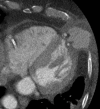Apical left ventricular false aneurysm after transapical transcatheter aortic valve implantation
- PMID: 24092466
- PMCID: PMC3867045
- DOI: 10.1093/icvts/ivt435
Apical left ventricular false aneurysm after transapical transcatheter aortic valve implantation
Abstract
Transcatheter valve implantation (TAVI) is becoming a routine procedure to treat severe symptomatic aortic stenosis. It is associated with complications different from those of conventional aortic valve surgery. We describe an 80-year old man who developed an apical left ventricular (LV) false aneurysm 3 months after transapical TAVI (TA-TAVI) complicated postoperatively by a surgical site infection (SSI). Three months earlier, an Edwards Sapien bioprosthesis no. 29 had been successfully inserted transapically because of severe comorbidities and a very large aortic annulus. His postoperative course was complicated by acute respiratory failure, gastrointestinal bleeding and a surgical site infection of the thoracic incision; Escherichia coli and Klebsiella pneumonia were isolated. After surgical debridement drainage and prolonged antibiotic therapy, the wound healed correctly. His emergency chest computed tomography upon readmission for the acute onset of a beating tumefaction at the TA-TAVI site showed a false aneurysm of the LV apex. The apex was closed directly during emergency surgery. The postoperative course was uneventful. Surgical site infection after TA-TAVI, its frequency, treatment and potential role as an underlying cause of this severe complication are discussed.
Keywords: False aneurysm; Surgical site infection; Transapical transcatheter valve implantation.
Figures
References
-
- Holmes DR, Jr, Mack MJ, Kaul S, Agnihotri A, Alexander KP, Bailey SR, et al. 2012 ACCF/AATS/SCAI/STS expert consensus document on transcatheter aortic valve replacement. Ann Thorac Surg. 2012;93:1340–95. - PubMed
-
- van der Boon RMA, Nuis RJ, Benitez LM, van Mieghem NM, Perez S, Cruz L, et al. Frequency, determinants and prognosis implications of infectious complications after transcatheter aortic valve implantation. Am J Cardiol. 2013;112:104–10. - PubMed
-
- Bleiziffer S, Ruge H, Mazzitelli D, Hutter A, Opitz A, Bauernschmitt R, et al. Survival after transapical and transfemoral aortic valve implantation: talking about two different patient populations. J Thorac Cardiovasc Surg. 2009;138:1073–80. - PubMed
Publication types
MeSH terms
LinkOut - more resources
Full Text Sources
Other Literature Sources
Miscellaneous


